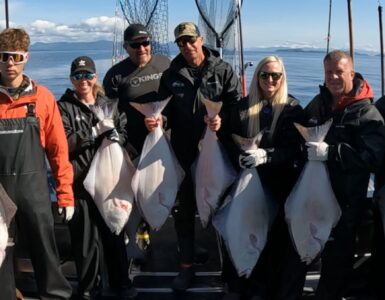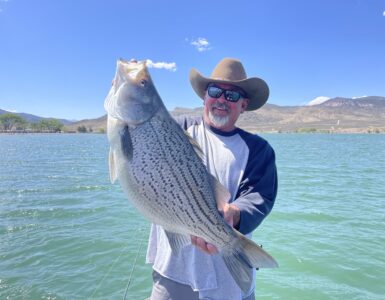(intro) Hey we’ve got a really fun story for you today. We’ve got Steve McGrath, Jeff Bringhurst and we are going swan, goose and duck. (steve) any and all of it and we’ve got our special guest Hank Shaw here today here too. (adam) thanks for coming out, all the way from California? (hank Shaw) Sacramento. (adam) very good, hey we are going to show him how to shoot the birds, he’s going to show us how to cook them. Perfect storm today, we’ve got a Northeast breeze, lets get on the water. (steve) I’m ready lets do it.
(Hank Shaw) It’s really rare to get a chance to hunt swans.
(jeff) we’re off.
(Hank Shaw, Hunter/Gatherer/Cook/Author) “There’s this old legend that the queen of England is the only person in the British Isles who is allowed to eat swans and she traditionally eats those on Christmas dinner. So I’m not the queen of England but I kind of want to see if I can do that and cook one for Christmas.” (laughs)
Hank Shaw is more known for his recipes than he is his prowess with a shotgun. Hank runs the wild foods blog Hunter Angler Gardener Cook, which won the James Beard Award for Best Blog in 2013. He’s also the author of two books that he hopes will, in his words “open the world of foraging, hunting and fishing to those interested in food.” Today he’s come to our Utah marshes to investigate a wild meat he’s never tried, the tundra swan.
Utah is one of three states in the Pacific Flyway that have hunts for tundra swans. Each year about five thousand hunters apply for one of the two thousand permits. We have five of those tags to fill today.
(Blaire Stringham, DWR; Migratory Game Bird Coordinator) “The reason behind the hunt is mostly for opportunity. We have ninety thousand plus swans here in the flyway.”
(Blaire) “Typically they’ll come from Alaska, northern part of Canada and they’ll have several different stopovers as they move their way towards California which is where their winter grounds are.”
(Blaire) “It’s a good opportunity for people to come out and harvest a bird that you really can’t in most other parts of North America at least.”
Our friend, Tony Smith and his Stone have already set up their spread. We join them…
(jeff Bringhurst, Waterfowl fanatic) let’s keep a majority of them close, like they are tucked in to the weeds, trying to stay out of the wind.
combining our spreads will give us seventy decoys to lure the birds in.
(Jeff) They’re coming to us.
(Adam) Ever done this before? (Dave Rearick (freelance writer) “Nope, never been to Utah.”
There are plenty of swans flying today…But.
our friend the wind, which was blowing from the north, has switched and is now slightly blowing right into our faces from the South. Not good!
The swans are giving us a look but not from the direction we had hoped, they’re coming in from behind.
(Blaire) They are not typically as shy, they are easier to get in than geese, or ducks and so often times you can go out and throw out garbage bags and they come into those or you can just stand on the dike and pass shoot them. Usually they follow the same paths as they move from their resting to feeding areas.
(jeff) Matt, Hank, you guys see them? (hank) yup. (jeff) Ok.
A little swan song and dance from Stone and soon we’ve got birds lined up to the horizon.
(Pitt guy) guys they are coming! About 25-30 of them. (jeff) low? (pitt) straight back. (jeff) oh yeah, yeah, yeah…
(david) yeah these three behind us are looking good. On the left? (david) yeah I see them.
(jeff) that’s my girl, come on girl, come one.
(Matt Anderson, Camp Chef) that just about landed in my lap! (adam) I know I saw that.
(Jeff) another good bird. (hank off cam) that’s a huge one. (jeff nodds)
Swan hunting seasons are designed to target tundra swans, which are much more numerous that trumpeter swans. The two swan species are very difficult to differentiate in the field. To monitor and limit accidental deaths of trumpeter swans due to misidentification by hunters, The Utah DWR has a quota of ten Trumpeter swans that can be taken each year.
(Blaine) Once we meet that quota we do have to have a mandatory shut down of the swan season. The closest we’ve ever come is we had seven one year.
(Blaine) We usually have two to three each year.
(jeff taking pic) you know that could probably win you a free camp chef thing. (steve) snapshot of the week baby! Right here, snapshot of the week.
Dave is last up last and boy did we put the pressure on. Five for five would be incredible.
(Dave Rearick, Freelance Writer) no pressure, (adam) Last tag. (dave) no pressure at all.
(david) how far? (adam) he’s coming. (NATS CALLING) (dave) too far or no? (tony) no he’s too far.
(Dave) too far or no? (adam) little far.
(Adam) He might make another loop on you.
(Adam Here comes the other two!
(ADAM) yup, here they come. To your right a little bit.
(Adam) they are coming to your 1 o’clock. Oh these might do it. They are coming down.
(?) take them! Shoot him! (shots, bird falls) yeah. (adam) nice job. (dave) that will work. That a boy!
Part of the agreement the DWR has with the US Fish and Wildlife Service to hold this hunt is the DWR is required to monitor the swan populations by an aerial survey, once a week from October through December. And hunters, well we have our part as well. Any swan taken, must be taken to a DWR office or the Bear River Bird Refuge to allow biologist to obtain measurements and to document any trumpeter swans that may be taken in the state.
(?) nice job buddy. (adam) under pressure, ten minutes to go. (?) boy they came in nice.
(tony Smith, Utah Hunter) We’ve got some hot gumbo now. (laughs)
(ADAM TAG) Not bad guys four for four and actually five for five. (steve) yeah, Hank got his work done and he’s off to work. (adam) he had to go sign some books in Salt Lake. Not your first one, but your first Utah swan. Yup. (adam) pretty cool, way to handle the pressure that was a tough one. We’ve got more coming up. In fact, Hank is going to show us how to bring the duck to the dinner table. That in just a moment, but first….
Back to the guys at Fish Tech for tonights Fishing Report.
________________________________________
(Adam) Welcome back to KSL Outdoors, I’m Adam Eakle, back here with Hank. Hank is in town giving a seminar to us duck guys on how correctly take the duck from the marsh and bring it to the dinner table and make it, well I like to say, I like eating duck but edible for my family. What is the first thing people should do? (hank) well I think the first thing you want to do is first think about the birds you’ve got and what you want to do with those. So, I mean if you’ve got off ducks like spoon bills or whatever. You should just skin those like you’ve always did. But if you’ve got good ducks, like a good pintail with some fat on it or a nice green wing teal. (adam) how about a can? (hank) especially a can, if you skin a canvasback, somewhere an angel dies. (laughs)
(Hank Shaw, Author “Duck, Duck, Goose”) what we go out and we harvest in the wild is some of the greatest meat we could possibly get, but you have to know how to cook it.
Hank is a late convert to hunting, but his cooking credentials speak for themselves. A former line cook, he’s caught fish and dug clams for a living, was a political reporter for 19 years but now he pays the bills writing about food. His wild game cookery has been published in several national publications.
(hank) The single biggest problem people have when they cook waterfowl is they treat them like birds. they are not birds in the kitchen.
(hank) Waterfowl, ducks and geese from a cooks perspective they are far closer to beef.
(hank) If you forget everything else that I tell you tonight, if you remember to cook breasts like a steak and legs like a brisket, you’ve won.
(hank) and there is a rule with cooking any birds. the bigger the bird, the lower the heat.
Hank gave a demonstration on how to break a bird down, he told us what type of birds you should pluck or breast out. He also talked about how to properly age your meat. All of this he covers including a detailed description of each recipe in his new book.
(hank) The reason why I wrote this book is because, in season I’ll eat duck 3-4 days a week and it’s endlessly fascinating, you can do so many different things with it.
(hank) this is why you go through all that effort to pluck your mallards, pluck your pintails or whatever, because this is literally a steak wearing a hat made of bacon. (laughs)
(mos) it’s really good.
I’m not much of a cook, but I do know good food and Hank’s duck breast and gumbo was some of the best I’ve ever had. If you want to try some of his delectable dishes, or maybe you want a gift for that hunter in your family. You’ll find Duck, Duck, Goose, on Amazon.com or locally at Barnes and Noble. Time now to check out this weeks edition of our Utah Field Guide.
________________________________________







Add comment